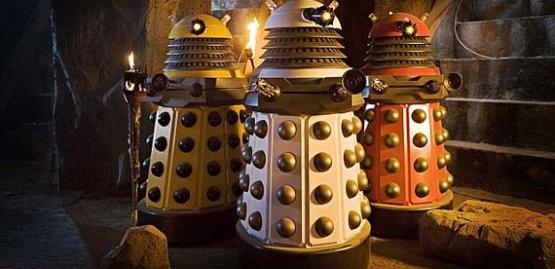Daleks

The Daleks, Deadly Robots from Dr. Who
Daleks from Dr. Who. Dr. Who, the British science fiction television program about a time-traveling humanoid alien is only one of the scores of fiction depicting robot or robot-like characters in its theme. The show is listed in the Guinness World Records as the longest-running science fiction television show in the world, and considered the "most successful" science fiction series of all time. The show ran from 1963 to 1989, and then re-launched in 2005.
Intended to be educational and family-friendly, Dr. Who tells the story of an extra-terrestrial Time Lord from the planet Gallifrey. He is a doctor who can travel through time and space in an “internally vast time machine called the TARDIS (Time And Relative Dimension(s) In Space),” which allows him to explore the universe at random, using his extensive knowledge of science, technology and own perspective of history. In his travels, he uses his knowledge to ward off troubles and get out of predicaments, which, owing to the old age and unreliability of the TARDIS's navigation system, often occur in his adventures. Earlier episodes alternated stories set in the past with stories set in the future or in outer space, to teach children about science and history.
Constantly battling monsters and cybermen, one of the Doctor’s most memorable adversaries comes in the form of a race of compassionless cyborgs from the planet Skaro. Created by the Kaled scientist Davros, the Daleks were designed as travel machines that would house his race and ensure his race’s survival against radiation and chemical poisoning. However, Davros deliberately removed all emotions from the mutants, resulting in a powerful race of creatures bent on universal domination.
These mutated Kaleds are integrated within a tank-like or robot-like mechanical casing made from a bonded polycarbide material called “dalekanium.” They have a single mechanical eyestalk mounted on a rotating dome, one exterminator arm containing a death ray and one telescopic manipulator appendage that resembles a sink plunger. These plungers may be used to for any of the following tasks: to interface with technology, extract information from one’s mind, measure a particular subject’s intelligence or crush a man’s skull. Although controlled by a creature inside its strong mechanical armor, Daleks are generally considered robots due to their appearance and emotionless character.
In his script, Terry Nation had stated that the Daleks should have no legs. He was inspired by a Georgian National Ballet performance, in which dancers in long skirts appeared to glide across the stage, and specifically stated that he wanted an alien creature that did not look like a “man in a suit.” Some accounts say that Raymond Cusick was given only one hour to design them. Fortunately, he had been sketching pepper shakers earlier and found his inspiration. Cusick has denied the story however, and says he based it on a man seated in a chair, and only used the pepper shaker to show how it might move.
The lower half of a Dalek's shell is embedded with hemispherical protrusions, or "Dalek bumps", which are part of a sensory array and can be functional in their self-destruct mechanism. Their armor contains a force field concentrated around their midsection, capable of evaporating most bullets and resisting most types of weapon; this seems to be concentrated around the Dalek's midsection where the creature is located. They are also equipped with energy weapons, one of which is an electrical plasma beam that can propagate through water.
The Daleks were controlled from inside by human operators who had to maneuver their eyestalks, domes and arms, and flash the lights in sync with the actors supplying their voices. Built in two pieces, an operator would go inside the lower section, and then the heavy top section would be secured. To be able to see, the operators had to look out between the mesh-lined cylindrical bars beneath the dome.
The voice of a Dalek is electronic, as the Dalek creature has no vocal apparatus for speaking. Their most famous line was "EX-TER-MIN-ATE!" with each syllable frantically screeched in an electronic scream. Another well-known line is "I OBEY!” This harsh, staccato style of their rising inflection was initially developed by voice actors Peter Hawkins and David Graham, who varied the pitch and speed of their lines according to the necessary emotion. After which their voices would then be processed electronically.
The early versions of the Daleks moved on nylon castors, controlled by the operator's feet. To enable them to travel more smoothly, designer Spencer Chapman built new shells around miniature tricycles with sturdier wheels, hidden by bigger fenders below the original base. Difficulties encountered in operating the prop has since been eradicated with the advent of the new series, where the dome and eyestalks are now remotely controlled. Operators could then focus on manipulating the arms and ensuring the smooth movement of the Dalek.
Redesigned by production designer Ed Thomas, under consultation from artist Bryan Hitch, producers Russell T. Davies and Julie Gardner, and model builder Mike Tucker, the new casings retain the general shape and dimensional proportions of previous Daleks, although they have been given a heavier and more solid look. The base is now larger and more pointed, the eyepiece has been given a glowing function and a metallic brass finish has been applied. Interestingly, because manufacturing the props was so expensive, in many earlier episodes, wooden replicas, enlarged photographs and even commercially available toys were used to represent them.
Although not robots (the Daleks are controlled by a creature from inside the casing), they are generally regarded as such, owing perhaps to their robot-like appearance, electronic voice and absence of any type of emotion, save their implacable belief of complete and utter superiority over all.